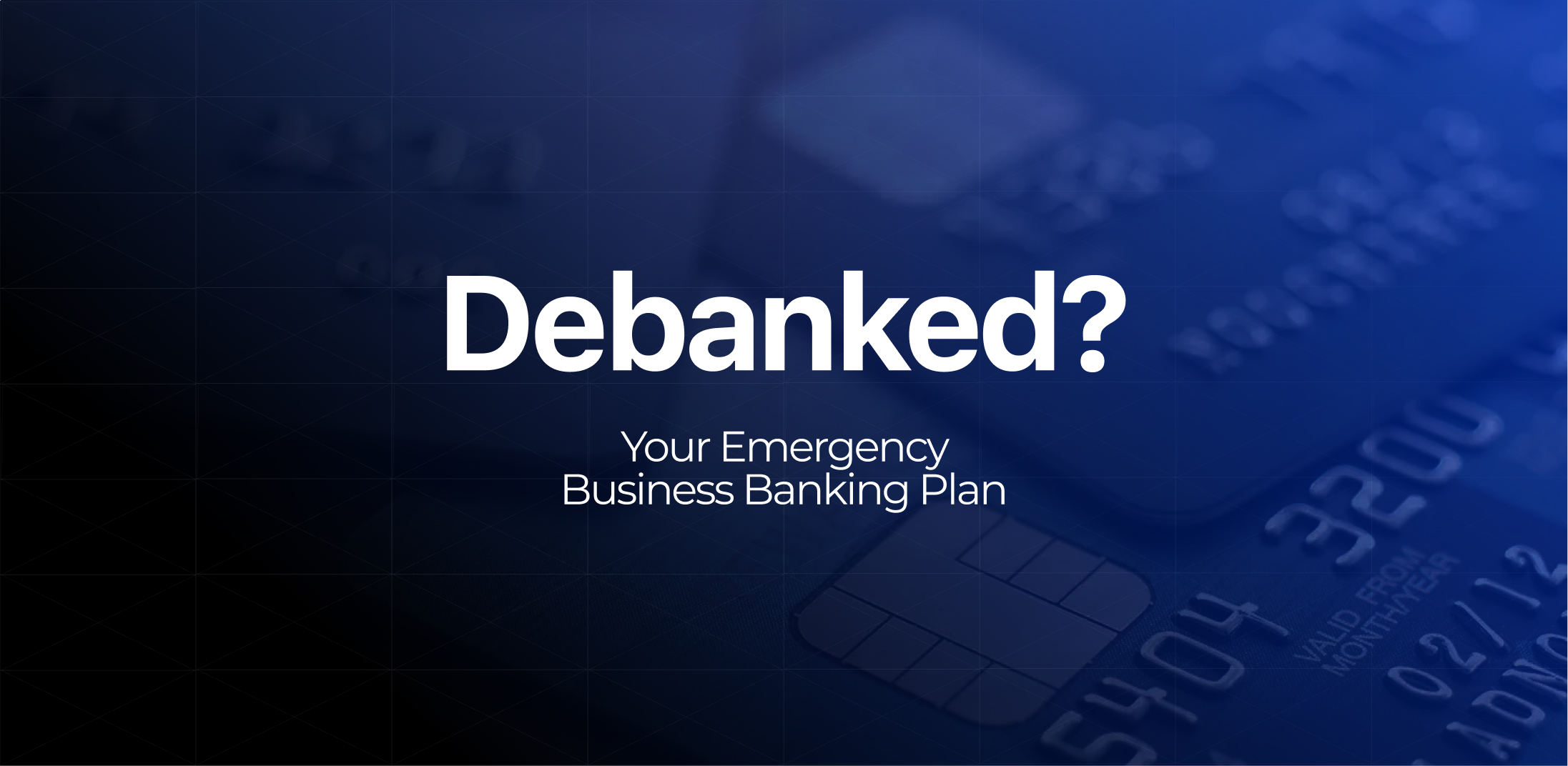In an increasingly unpredictable financial environment, more and more companies are facing an unsettling challenge: being debanked with little or no notice. In business terms, debanking occurs when a financial institution abruptly shuts down a company’s account – often without a detailed explanation. The fallout can be immediate and severe: halted transactions, missed payroll, and frozen vendor agreements.
For firms in regulated or perceived high-risk sectors like cryptocurrency, online gaming, or cross-border commerce, this risk is no longer rare – it’s becoming the norm. The rise in debanked businesses has been particularly sharp in the last two years, as traditional banks react to tightening global regulations, including enhanced AML (anti-money laundering) and KYC (know-your-customer) standards. Even businesses that maintain full compliance are finding themselves unexpectedly locked out of essential financial infrastructure.
Whether your company has already experienced this or is vulnerable to it, the need for a contingency plan is urgent. In this article, we’ll examine what to do when your account is unexpectedly closed, review the latest debanking trends for 2024–2025, and offer a step-by-step guide to building a reliable Emergency Business Banking Plan. By exploring practical debanked business solutions – Emergency Banking, you can ensure business continuity even when traditional systems fail.
Debanking Services Trends in 2024–2025
Recent figures reveal a troubling surge in business account terminations – a growing issue now widely recognized as debanking. In the UK, eight of the country’s largest banks reportedly closed nearly 140,000 SME accounts in 2023 alone, representing close to 3% of their total business customer base. Alongside this, formal complaints concerning involuntary account closures spiked by 44% year over year, pointing to rising dissatisfaction among entrepreneurs and finance managers.
This shift has hit certain sectors harder than others – particularly those flagged as high-risk. Industries such as cryptocurrency, adult entertainment, online gaming, offshore consultancy, and companies operating under high-risk merchant category codes (MCCs) face the highest exposure. AIMA’s recent survey found that three out of four crypto hedge funds struggle to retain banking partners, and 98% were given no rationale for potential service refusal.
Supporting this trend, Anchorage Digital’s Regina White noted that over 40 banks declined their business due to general anti-crypto stances. These developments illustrate the wider Debanking trends in 2024-2025. What’s driving this wave? Increasingly aggressive regulatory enforcement. Financial institutions are boosting their KYC and AML protocols, resulting in millions of Suspicious Activity Reports (SARs) annually. In the U.S. alone, 4.6 million SARs were filed in the last year, spurred by global pressure to mitigate reputational and compliance risks.
Perhaps most concerning is the unpredictability: closures are frequently executed without prior notice or sufficient justification, and there’s often no formal appeals process. For businesses, this means scrambling to secure an emergency EMI account to restore financial operations. As this climate becomes more volatile, understanding and adapting to the latest debanking trends in 2024–2025 is no longer optional – it’s essential for survival.
What to Do the Moment You’re Debanked

Learning that your account has been closed by the bank, often without prior notice, can disrupt your entire operation. In these moments, time is critical. Acting with precision and professionalism can help you safeguard business continuity and maintain trust with partners and regulators.
Step 1 – Retrieve Accessible Funds Immediately
If your account still contains available funds, act without delay. Some banks impose a temporary freeze before a full shutdown. Reach out to your bank representative or customer support to request a formal withdrawal or transfer. Always communicate in writing and keep detailed records of all correspondence.
Step 2 – Ask for a Closure Statement
Although financial institutions aren’t always obligated to give detailed reasons, requesting an official explanation is a crucial step. Determine whether the closure stems from compliance concerns, internal risk policies, or external regulatory pressure. Even limited insight can shape your next move.
Step 3 – Organize Your Regulatory Documents
Compile all essential paperwork immediately: KYC data, financial records, client contracts, tax returns, and business licenses. If the account closure resulted from compliance red flags, this documentation will be vital when applying for a new provider or an emergency EMI account.
Avoid Costly Missteps
Don’t resort to quick fixes like using personal accounts for business or engaging unauthorized financial platforms. These decisions can lead to legal trouble and compromise your reputation in the financial ecosystem.
In crisis scenarios, calm, calculated action is key. A strategic response, grounded in speed, documentation, and professionalism, can help you recover faster and rebuild your banking infrastructure with minimal disruption.
Building Your Emergency Banking Plan

For today’s businesses, particularly those in high-risk or rapidly evolving industries, readiness for unexpected financial disruptions is essential. As incidents of accounts being closed by banks continue to rise, having a robust Emergency Banking Plan can be the key factor between a minor setback and a full-scale operational crisis. Whether you’re launching a startup or managing a growing enterprise, establishing a contingency framework in advance is critical to preventing the sudden and damaging effects of becoming a debanked business without notice.
The Importance of an Emergency EMI Account
Having a backup account with an Electronic Money Institution (EMI) offers essential continuity for your business. It provides rapid access to funds, enables ongoing client payments, and supports invoicing operations – even if your main banking partner unexpectedly severs ties. Unlike traditional banks, EMIs often offer faster onboarding and are particularly suited to businesses dealing with international clients, multiple currencies, or digital assets.
Your Emergency Banking Essentials
To create a resilient contingency plan, your emergency setup should include:
- Secondary EMI or fintech account: Establish accounts with reputable EMIs to ensure service continuity across multiple providers.
- Multi-currency wallet solutions: Facilitate global transactions smoothly without dependence on a single financial channel.
- Crypto-to-fiat conversion tools: If your revenue includes crypto, ensure you have efficient, compliant mechanisms to convert digital assets into fiat when needed.
- Up-to-date documentation: Keep your KYB (Know Your Business) files, client contracts, invoices, and tax records organized and ready to present to any new provider.
Prioritize Global Access and Fast Onboarding
Select partners that support cross-border operations, provide multilingual service, and offer 24/7 onboarding assistance. In emergency situations, onboarding speed is critical – being able to activate an account in a matter of hours can prevent damaging interruptions to cash flow.
With debanking trends in 2024–2025 on the rise, a preemptive strategy is your best safeguard. Don’t wait until your account is closed by the bank – put your emergency infrastructure in place now to ensure your business remains protected and operational.
Debanked Business Solutions – What Really Works?

When your bank unexpectedly shuts down your account, regaining access to essential financial tools becomes an urgent task. However, not all replacement options are created equal—there are major differences in speed, dependability, and regulatory standards. With debanking trends in 2024–2025 accelerating, the most adaptable and resilient companies are those that proactively establish relationships with trusted, agile, and fully compliant alternative business banking providers.
Fintech EMIs – Fast, Borderless, and Regulation-Ready
Electronic Money Institutions (EMIs) like PaySaxas, Revolut Business, and N26 Business have become essential tools for companies needing rapid access to payment infrastructure. These fintech solutions offer streamlined onboarding, multi-currency accounts, and real-time foreign exchange – making them ideal for globally active businesses and agile startups.
PaySaxas stands out for its specialized support of companies that face obstacles with traditional banks, offering fully compliant account solutions tailored for sectors often labeled high-risk.
Multi-EMI Hubs – Simplifying Provider Choice
Using platforms that consolidate multiple EMIs gives businesses the ability to compare account features, compliance requirements, and onboarding speeds all in one place. This centralized approach minimizes disruption and makes it easier to switch or maintain multiple providers as a safeguard against unexpected account closures.
Digital vs. Traditional Banks – The Compliance Gap
Digital banks have carved out a competitive edge by simplifying KYC processes and offering rapid digital account setup. While traditional banks still play a role – particularly in lending and long-term financing – their rigid frameworks often fall short for fast-moving, international businesses. In contrast, digital institutions provide the flexibility and automation needed in today’s real-time economy.
Industry-Aligned Solutions Matter
If your business operates in crypto, adult content, gaming, or other high-risk areas, working with financial partners familiar with these sectors is crucial. Look for providers who understand the compliance demands of your niche and offer tailored risk management strategies.
For any debanked business, choosing the right mix of alternative business banking partners ensures resilience. Being prepared today means you won’t be left unbanked and scrambling tomorrow.
Long-Term Strategy to Protect Your Business
Surviving a sudden account closed by bank scenario is only part of the challenge—building long-term financial resilience is what will keep your business stable in an increasingly unpredictable environment. With regulatory scrutiny tightening and risk tolerance shrinking across the financial sector, companies must take proactive measures to safeguard their access to essential banking services.
1. Open Accounts in Multiple Jurisdictions
Depending solely on one bank, or even one regulatory region, can expose your business to unnecessary risk. Establish financial relationships across various countries to hedge against local regulatory changes. Holding both EU and non-EU EMI accounts can offer greater agility and more reliable access to funds during a crisis.
2. Stay Ahead with Ongoing Compliance
Be proactive, not reactive. Regularly update your KYB (Know Your Business) files, financial statements, contracts, and client data. Having these documents ready at all times not only speeds up onboarding with new providers but also strengthens your defense if your business comes under compliance review.
3. Separate Risk-Intensive Revenue Streams
If your business operates in multiple verticals, isolate high-risk income sources into their own entities. Dedicated accounts for each stream prevent potential compliance issues in one area from affecting the entire organization.
4. Distribute Funds and Use Multi-Sig Wallets
If you’re in the crypto space or manage large volumes of funds, consider using multi-signature wallets and diversifying your holdings across several financial platforms. This reduces the chance of total loss from internal errors or a single provider freeze.
5. Build Direct Rapport with Financial Partners
Strong relationships with account managers or compliance teams at your financial institutions can provide critical insights, personalized service, and faster resolution if problems arise.
In a landscape where your account could be closed by a bank with little warning, forward-thinking planning is essential. Putting these measures in place now is your best line of defense against financial disruption.
Conclusion: Future-Proofing Against Debanking
In today’s unpredictable financial landscape, waiting until your account is shut down by a bank is a gamble no business should take. The surge in debanking cases, driven by stricter compliance protocols and increasingly cautious banking practices, underscores the urgent need for proactive planning. Whether you operate in crypto, online services, or global consulting, the risk of becoming a debanked business is no longer remote – it’s a growing reality.
The banking world is evolving rapidly. Traditional systems are giving way to digital-first, regulation-focused models that require businesses to be flexible, responsive, and always prepared. Those who succeed in this new environment will be the ones who stay ahead of the curve, with backup systems and compliance strategies already in place.
Take a moment to assess your vulnerabilities: Are all your funds tied to a single institution? Are your KYB documents up to date? Do you have access to a reliable emergency EMI account? Don’t wait for disruption to force your hand. Act now – build your emergency banking infrastructure and future-proof your financial operations.








